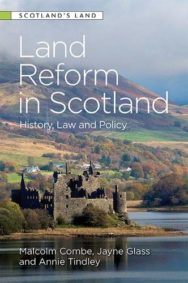‘This engagement with the history of the land question continues throughout the twentieth century. It is evident in the work of Aonghas MacNeacail, especially in his poem ‘oideachadh ceart’ (‘a proper schooling’). In this poem MacNeacail asserts that a series of incidents from the life of the township of Idrigill, Skye, are not events from history but part of the memory of the township: they are alive and connected to the present, rather than being past and archived.’
Land Reform is as topical as ever in Scotland. A stimulating review of the contemporary scene, this volume offers a holistic approach, covering how Scotland’s land is regulated, used and managed, and makes some suggestions as to the future of land reform. Here we feature two extracts, the first from the introduction, and the second, from the chapter by Ewen A. Cameron on ‘The Strange Survival of the Scottish Land question’.
Extracts taken from Land Reform in Scotland: History, Law and Policy
Edited by Malcolm M. Combe, Jayne Glass, and Annie Tindley
Published by Edinburgh University Press
FROM INTRODUCTION
One of the significant challenges faced by the editors and contributors to this volume was the hotly contested nature of the longstanding political controversy that is glibly summed up in the phrase ‘the land question’. This points to questions with deeper roots: what role can and does academic research of any discipline play in an intensely political debate? Is there such a thing as an objective point of view on fundamental questions for our society such as the ownership, use and management of the finite resource that is land? Each of the contributors here have been considering these questions from their own disciplinary and personal perspectives, and collectively, we wish to make a contribution to a lively, important and ‘unsafe’ debate. As such, the volume is designed to support and inform current public debate, not become a direct part of it. The main reason for this is to prevent – as far as possible in a fast-changing field – early dating and obsolescence of the work presented here. A further reason is that this is not intended to be a ‘campaigning’ or polemical volume, supporting any of the myriad stances on land issues in Scotland. Instead, it is intended to present and critique the various viewpoints on, and contexts of, land reform. Land reform has long been and continues to be an ‘unsafe’ area for academic (and non-academic) study: it is fraught with tension and remains highly emotive. The political, economic and social stakes are high and this can be traced in some of the contributions here, both historically and in contemporary debate.
As well as the highly contested nature of the debate, there are other problems of bias and emphasis. One of these is the tendency towards the ‘Highlandisation’ of the land reform debate, and a reminder not to ignore either the Lowlands or urban land questions. In part this is due to historical legacy – many of the key events and reforms took place in the Highlands and Islands first, and therefore they tend to loom large. However, recent land reform has been characterised by less-expected geographies, for example, the proposed Wanlockhead community purchase, or recent provisions for urban community landownership, or, going back a little further, the Glasgow rent strikes of the First World War period.
The contributors to this volume have worked to provide a much more rounded and geographically inclusive picture as a result. At the root of many of the issues outlined already are the power and problems of defining key concepts in the land reform debate. Terms such as ‘community’, ‘private benefit’ and ‘public good’ are used extensively in political debate and the wider literature, but conflicting or confused meanings attached to these can generate misunderstandings or even rancour, whatever disciplinary or political standpoint an observer takes. We do not propose that this volume will present the definitive word on any of these concepts but we do hope that it will help establish some common ground.
FROM ‘THE STRANGE SURVIVAL OF THE SCOTTISH LAND QUESTION.’
Issues concerned with the ownership of, access to and redistribution of land have remained more important in Scotland than in other parts of the United Kingdom. The politics of the land question are reflected in many areas of Scottish culture. Significant works of twentieth-century Scottish literature, in both Gaelic and English, are concerned with the histories and geographies, communities and places, grievances and aspirations, associated with land. The clearances and the Crofters War of the 1880s are prominent in this body of work. This engagement with the history of the land question continues throughout the twentieth century. It is evident in the work of Aonghas MacNeacail, especially in his poem ‘oideachadh ceart’ (‘a proper schooling’). In this poem MacNeacail asserts that a series of incidents from the life of the township of Idrigill, Skye, are not events from history but part of the memory of the township: they are alive and connected to the present, rather than being past and archived. Perhaps the most sustained piece of writing to explore themes relating to the wider social and cultural impact of the land question is Sorley MacLean’s ‘An Cuilithionn’. This poem attempts to relate the island of Skye to themes in European and global history in the 1930s, the period in which most of the poem was written, although it was not published in full until the 1980s. The clearances and the crofters’ response in the 1880s are at the centre of the Skye history from which themes of global relevance emanated.
Writers in English also produced important works centred on the clearances and the land question. Neil M. Gunn’s Butcher’s Broom (1934) contained an extended discussion of the impact of the clearances on a community in Sutherland. The Silver Darlings followed in 1942, a sequel to Butcher’s Broom in the sense that it looked at the fishing communities of the Moray Firth in the aftermath of the Napoleonic Wars. Gunn was concerned with the history of the land question in his fiction and carried out detailed historical research. Gunn was a pragmatic nationalist and this comes through from one of his later novels, The Drinking Well (1946). This book deals with economic conditions in the central Highlands during the 1930s. It is full of set-piece scenes where characters debate nationalism and agricultural problems. Not so heralded as Gunn, but perhaps the first novelist to deal directly with the clearances, was Ian MacPherson. Better known for his Shepherds’ Calendar and his dystopian Wild Harbour, MacPherson drew on his father’s knowledge of the sheep-farming industry to write two novels, Land of Our Fathers (1933) and Pride in the Valley (1936), about the clearances and their aftermath. These novels were the starting point for MacPherson’s ideas about economic development in the post-clearance and contemporary Highlands, an important theme of his journalism.
Like Gunn, MacPherson was drawing on history to inform contemporary debates about the land question. Later works that touched on these themes included Fionn MacColla’s And the Cock Crew (1945) and Iain Crichton Smith’s Consider the Lilies (1968). These were important novels, although slightly distinct from those considered above in that they concentrated on the theme of the ‘betrayal’ of the people by the clergy of the Church of Scotland and, compared to the work of Gunn or MacPherson, were less concerned with historical chronology and ‘accuracy’.
These are important works in the history of Scottish literature but they are important in a history of the Highland land question for other reasons. In the period from the 1930s to the 1970s these and other works did much to keep the issue alive in the minds of a wider public who may not have been directly affected by the grievances associated with Scotland’s systems of land ownership and tenure. The most important work, however, was The Cheviot, the Stag and the Black, Black Oil, first performed in 1973. This play dealt with the ways in which the Highlands had been exploited by sheep farmers, landlords, sporting tenants and, in the later twentieth century, the forces of international capitalism represented by the oil industry. The text also dealt with the ways in which the people of the Highlands fought back against such forces.
In combination with the new and assertive West Highland Free Press, the reaction to The Cheviot helped to raise the profile of the land question in Scottish politics at a particularly interesting moment when mainstream politics provided few fresh ideas on the matter.
Land Reform in Scotland: History, Law and Policy edited by Malcolm M. Combe, Jayne Glass, and Annie Tindley is published by Edinburgh University Press, priced £19.99.
ALSO IN THIS ISSUE

 Wild Winter: In search of nature in Scotland’s mountain landscape
Wild Winter: In search of nature in Scotland’s mountain landscape
‘Out of the gloom swaggers a powerful creature, the master of this glen. He is so close that I feel …

 The Black Cuillin
The Black Cuillin
‘What is special about the Cuillin is that they are Britain’s only true mountains, comprised of narr …













